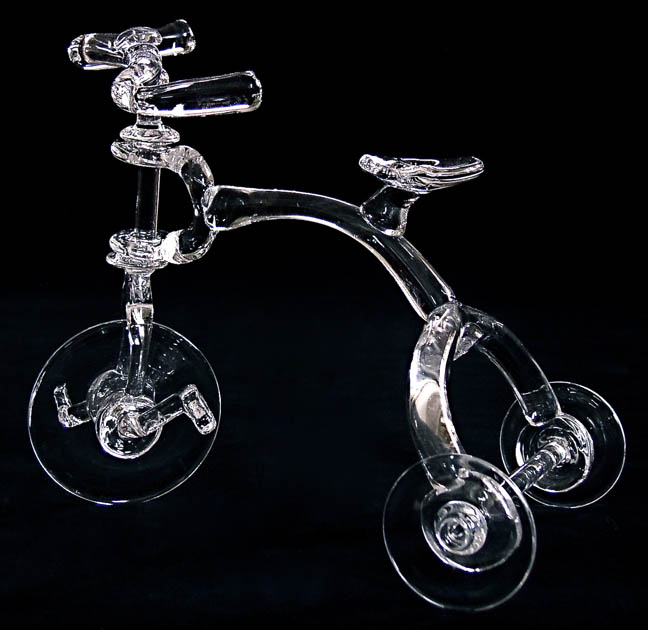

Title: Handblown Sculpted Glass Tricycle By Artist Andrew Paiko
Shipping: $69.00
Artist: N/A
Period: Contemporary
History: N/A
Origin: N/A
Condition: Museum Quality
Item Date: 2010
Item ID: 3952
"Tricycle #1" Sculpted and assembled glass 9"H/9"W/6"D It takes 4 to 6 weeks to make. Handblown Glass Tricycle. This is handblown glass, all hand assembled by the artist. Glass Tricycle. This is a cool looking over sized glass Tricycle. blown, sculpted, assembled glass. This glass Tricycle is large. It is a great art display and decoration." Andy Paiko seems to have more than a bit in common with glass. There is a palpable sense of dedication to finely wrought craftsmanship and to the lusciousness inherent in the material itself. There is also a fascination with science, particularly with Natural History, and with preserving and celebrating relics from the natural world. Somehow, I suspect that all of the above were also ardent fans of Ole Worm‘s taste in collecting. Like something from a Cabinet of Curiosities discovered in a dream, Andy Paiko’s mixed-media glass sculptures are mysterious, exquisite and very, very covet-worthy. Paiko’s sculptural vessels include a dizzying array of baroquely ornate glass bell jars, designed to house bones, shells, coral and other natural (and sometimes gold-plated) treasures. A related show-stopper is a glass chair, with compartments designed to accommodate objects, including a rhesus monkey skull and rodent skeleton.
Link: http://en.wikipedia.org/wiki/Glass_art
Glass art and glass sculpture is the use of glass as an artistic medium to produce sculptures or two-dimensional artworks. Specific approaches include stained glass, working glass in a torch flame (lampworking), glass beadmaking, glass casting, glass fusing, and, most notably, glass blowing. As a decorative and functional medium, glass was extensively developed in Egypt and Assyria, brought to the fore by the Romans (who spread glassblowing, invented by the Phoenicians), and includes among its greatest triumphs European cathedral stained glass windows. Great ateliers like Tiffany, Lalique, Daum, Gallé, the Corning schools in upper New York state, and Steuben Glass Works took glass art to the highest levels. Glass from Murano (also known as Venetian glass) is the result of hundreds of years of refinement and invention. Murano is still held as the birthplace of modern glass art. The glass objects created are intended to make a sculptural or decorative statement. On the market, their prices may range from a few hundred to tens of thousands of dollars (US). Prior to the early 1960s, the term "glass art" referred to glass made for decorative use, usually by teams of factory workers, taking glass from furnaces with a thousand or more pounds of glass. This form of glass art, of which Tiffany and Steuben in the U.S.A., Gallé in France and Hoya Crystal in Japan, Royal Leerdam Crystal in The Netherlands and Kosta Boda in Sweden are perhaps the best known, grew out of the factory system in which all glass objects were hand or mold blown by teams of 4 or more men. The turn of the 19th Century was the height of the old art glass movement while the factory glass blowers were being replaced by mechanical bottle blowing and continuous window glass.